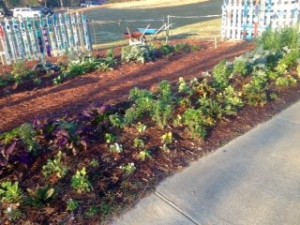Fall Planting Tips To Create A Great Spring Garden:
-
Amend your soil. You might think since you followed our advice and added soil conditioner, PlantTone, or compost to your beds last spring you’re done. Not so fast! High temperatures break down soil amendments quickly, and plants take up nutrients. Continue adding to your soil every season. Healthy, loose soils create healthy plants. (Instead of putting fallen leaves to the curb, start a compost pile with them, or run over them with your lawn mower and throw them in your beds. They’ll decompose and add to your soil’s structure and health.)
- After you get your plants home, be sure to keep them watered, especially if you can’t plant them right away. We water small transplants in 4″ pots and cell packs at least once a day, especially if it’s hot and sunny. Of course, less water is required in cloudy, cool conditions. Right before you plant them, be sure they’re moist.

- Early in the season while the soil is still warm, you can still plant with Osmocote. However, later in the winter months, use Calcium Nitrate to feed your plants, especially if the foliage of your pansies turns a reddish color. Remember, you’re planting for spring color, though on warm days through the winter you should also have some blooms.
- Water your bed thoroughly after planting, and keep it watered while your transplants are getting their feet settled in their new home. Take care not to overwater, though, especially as the temperatures cool down going into the winter months.
- Mulch your beds with shredded mulch or pine straw to keep soil temperature around the roots as warm as possible.
- Deadhead your pansies and violas! I can’t stress enough how important this is. A pansy that you leave a dead bloom on will form a seed there, instead of putting that energy into more flowers. Make a practice to walk through your garden at least once a week, taking a good look at your plants and deadheading faded blooms. If you’ve missed some, you’ll see the seed pod beginning to form. Pinch any and all off! This will go a long way toward keeping your pansies happy!
Have you seen any of the videos we’ve been posting on our FB and Instagram? If you follow us, maybe you have! If you’re not on social media though, you can also find us on our YouTube Channel. Yes, we have a YouTube channel! Just search for Oak Street Garden Shop, and subscribe if you’d like to see more!
By Kris Blevons
– Posted using BlogPress from my iPhone




















 Snapdragons can be purchased in the fall in cell pack flats and in larger pots as well. Many times they’ll be in bloom. When theses initial bloom spikes are finished, cut them back below the faded flowers. This will ensure they’ll branch and be fuller and more robust. Through the winter the plant’s energy will go into growing roots and strong leaves – the beautiful blooms next spring are your reward!
Snapdragons can be purchased in the fall in cell pack flats and in larger pots as well. Many times they’ll be in bloom. When theses initial bloom spikes are finished, cut them back below the faded flowers. This will ensure they’ll branch and be fuller and more robust. Through the winter the plant’s energy will go into growing roots and strong leaves – the beautiful blooms next spring are your reward!



